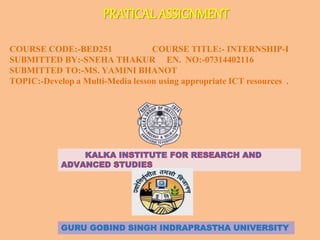human heart-structure and function
- 1. PRATICAL ASSIGNMENT COURSE CODE:-BED251 COURSE TITLE:- INTERNSHIP-I SUBMITTED BY:-SNEHA THAKUR EN. NO:-07314402116 SUBMITTED TO:-MS. YAMINI BHANOT TOPIC:-Develop a Multi-Media lesson using appropriate ICT resources . GURU GOBIND SINGH INDRAPRASTHA UNIVERSITY
- 3. WHAT IS HEART? Heart is a pumping organ of the body that keep the blood flowing and continuously moving in blood vessels. It beat continuously ,Non-stop throughout the life
- 4. Human heart is about the size of your closed first and is present at the Centre of chest cavity Slightly tilted toward the left
- 18. PULMONARY VEIN AORTA VENA CAVA PULMONARY ARTERY
- 21. If you count the number of throbbing occurs in a minute, it is called pulse rate.
- 22. 1.Place your index and middle fingers in the groove on the inside of the wrist. Just slide your fingers across the tendons until they slip into soft tissue. 2.Wait until you clearly feel beats coming with a regular rhythm. 3.Count the number of beats for 15 seconds and multiply by 4 (or for 30 seconds and multiply by 2) to get the number of beats per minute.
- 23. Contraction and relaxation of heart is called heart beat
- 25. I listen your heartbeat by using a stethoscope
- 30. LEFT VENTRICLE
- 32. VENA CAVA
- 34. RIGHT ATRIUM
- 36. PULMONARY ARTERY
- 38. AORTA
- 40. PULMONARY VEIN
- 42. LEFT ATRIUM
- 44. TRICUSPID VALVE
- 46. AORTIC VALVE
- 48. RIGHT VENTRICLE

















































